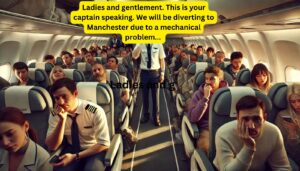
How do pilots decide whether to continue a flight or turn back when there’s a problem?
On March 7, passengers on a Virgin Atlantic flight endured an eight-hour ordeal after their plane turned back toward the UK despite being near to North America.
The Airbus A350 was just 330 miles from the Canadian coast when it made a U-turn over the Atlantic. Virgin Flight 3, traveling from London Heathrow to New York’s JFK Airport, eventually landed safely at Manchester Airport due to what the airline described as a “technical issue.”
A typical flight time from London Heathrow (LHR) to New York JFK (JFK) on an Airbus A350 is around 7 to 8 hours westbound and around 6 hours eastbound.
This is because, for Westbound flight, the plane is flying against the jet stream whereas for the Eastbound return flight the aircraft has the benefit of a tail wind.
Flight duration varies depending on factors like winds, air traffic control routing, and departure delays. The eastbound flight is usually faster due to the jet stream tailwind over the Atlantic.
This incident raised questions about how pilots decide whether to continue a flight or turn back. Wouldn’t reaching the destination be a better choice than enduring an eight-hour return flight and not going anywhere?
Pilots follow a structured decision-making process when determining whether to proceed or turn back. They consider four key factors: safety, feasibility, legality, and economy. The decision hinges on the severity of the issue, aircraft performance, and potential risks.
Minor issues, such as a failed galley oven or inoperative cabin light, typically do not require a return. However, major problems—engine failure, hydraulic issues, pressurization problems, or medical emergencies—demand immediate assessment.
In the case of Virgin Flight 3, the crew likely followed diversion protocols. The most critical in-flight emergency is fire, which necessitates an immediate landing at the nearest airport. Virgin Atlantic cited a “technical issue” as the reason for the diversion, though details were not disclosed.
Legally, a four-hour return was permissible, as the Airbus A350 is certified for ETOPS-370, allowing for a theoretical six-hour single-engine diversion. If adverse weather at the departure airport made returning unsafe, the captain could opt for an alternate landing site.
Economic considerations also play a role. Landing at a foreign airport can incur significant costs, including landing fees, passenger accommodations, and logistical challenges. However, safety always takes precedence.
The decision to continue or turn back is complex and depends on multiple factors, including the nature of the problem, aircraft performance, weather, fuel status, and regulatory requirements.
Pilots are trained to prioritize safety above all else, ensuring the best possible outcome for everyone on board.
Watch ‘Flight VS3: A Travel Nightmare from London to New York’
here https://www.tiktok.com/@aircrash_captain/video/7478809340493794582